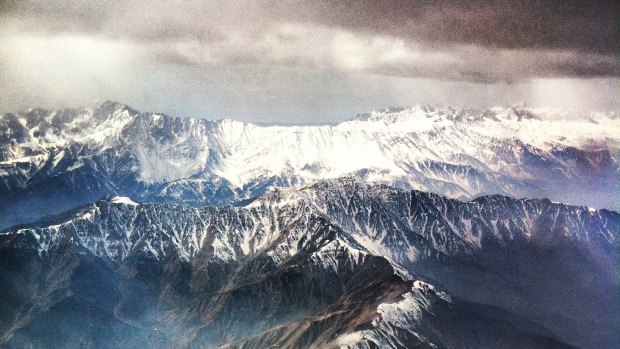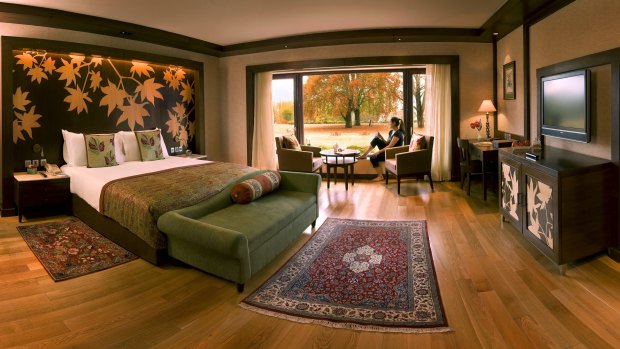By Catherine Marshall

Peak experience: Kashmir from the air. Credit: Catherine Marshall
There is danger and delight around every corner in Kashmir.
They are shooting down in the valley of Pahalgam. My guide, Younis, grey-green eyes ablaze, body snapped to attention, slams his fist into the car seat and urges the driver, Mr Rouf, onwards. Kashmir's mountains gather tightly around us, their jagged tips rising so high they extinguish the afternoon sunlight. We're no longer driving along the KP Road towards Anantnag, it seems, but are burrowing instead through the geological innards of this magnificent, oppressive range.
Just hours earlier, we'd come to the hill station of Pahalgam in Jammu and Kashmir from the state's summer capital, Srinagar. Autumn's advance was well under way, yet we'd driven through a tunnel of bright willow trees, past apple groves and fields of saffron where colourfully-clothed figures picked the last of the summer flowers. We'd passed through Sangam, famous for its willow cricket bats, and had crossed the bridge beneath which floodwaters converge each year once winter's icy armour has melted.

Safe haven: Hotel room in the Lalit Grand Palace.
I'd been wary of violence; for decades, Kashmiri separatists and the region's proximity to Pakistan, China and Afghanistan had deterred even local travellers from exploring this spectacular mountainous region of far north India. The only foreigner on the flight from Delhi, I'd been waylaid at Srinagar's airport by a rifle-bearing official who ordered me to fill in a special form. Exploring Kashmir, I noticed the netting draped over buildings to mitigate the damage caused by riots, and was bemused at the paradox of armed soldiers patrolling the rooftops of shops selling everyday goods and services: Rafiq Enterprises, Coral Garments, The Divine Academy.
But despite this visceral reminder of a once-entrenched conflict, it was clear that time had soothed political wounds. Kashmiris, largely Muslim, have forged a tentative peace with majority Hindu Indians, and at last people are returning: the tourists from Gujaratand Maharashtra, the skiers from Germany and the Netherlands, the Bollywood stars who decades ago adopted Srinagar as their summer base, fleeing Mumbai's cruel heat to make movies against a backdrop of chilled rivers and snow-bright peaks.
And so it transpires that the shooting going on down in the valley of Pahalgam is not of the militia variety; rather, a movie crew has set up its cameras at a military post beside the glacial Lidder River and is filming a scene for Haider, a Bollywood adaptation of Hamlet.
Mr Rouf pulls up behind a long line of cars clogging the pass and Younis jumps out, gesturing for me to follow. Visitors to the hill station have abandoned their picnics and are crowding around the shoot, craning for a glimpse of heartthrob Shahid Kapoor. "Cut!" says the director, and now Kapoor weaves through the crowds, brushing right past me and disappearing into a roadside tent. Later, he will shave his mop of thick, glossy hair and go shopping incognito in Srinagar, buying up in peace and quiet that most traditional of Kashmiri gifts, the pashmina.
The Bollywood legend is omnipresent back at my hotel, the Lalit Grand Palace, which sits in the foothills of the Himalaya Range and overlooks Srinagar's centrepiece, Dal Lake. Once a maharajah's palace, it served as a base for Bollywood studios from the 1950s, hosting celebrities and royalty, throwing glittering parties, staging concerts in its capacious gardens until trouble came to Kashmir in the late 1980s. A decade later the palace, now strangled by brambles, its carpets rotting and roof caved in, was refurbished; it was a startling revival that locals believe put Jammu and Kashmir back on the tourist map.
I sense this renewed influx of tourists most acutely at Gulmarg, the mountaintop meadow which transforms into a ski resort beneath winter's bombardment of snow. To get there we must take the highway that leads north to Pakistan, overtaking plump yellow school buses, passing lopsided houses with corrugated roofs and wooden shutters, golden hay bales wedged into the crooks of trees, plots of turnips and radishes, and fields that will bloom with mustard in spring and rice in summer.
Halfway up the mountain, Mr Ismael is waiting for me. We scramble up a steep ridge where a lone soldier stands sentry, and emerge at the intersection of Zig Point and the Outer Circle. The view is astounding: peaks stacked one behind the other in inky gradations; sun-dust sifted into scooped-out valleys; the metallic
Built in the late 1800s for horse trekking Brits, the Outer Circle is an imprimatur of sorts – along with St Mary's Church nearby – denoting Britain's once-fierce imperial hold on India. But today Mr Ismael and I are the only ones here. Sunlight trickles down through the canopy and bounces off last year's snowfall, which lies unmelted in the earth's deep folds.
"In Kashmir, you should dress like a Kashmiri woman," Mr Ismael says, wrapping my scarf around my head in the local colloquial style.
We walk on through the forest of alpine firs and pines and wild maples, accompanied only by birdsong. Finally we emerge from the forest and find we're no longer alone: multitudes of Indian tourists have come here by road, impatient to toboggan down the snow that's already transforming this mountainside into a winter dreamland. A gondola carries us to the first lookout where we drink kahwa tea infused with saffron, cinnamon, cardamom, almonds, cashews and dried fruits; but poor weather has closed the second peak, and so I abandon my dream of viewing the Pir Panjal Range from a lofty 14,000 feet.
On the highway to Leh next day, Mr Rouf must pay a 100 rupee bribe at a military roadblock. This is how business is done here, ma'am, Younis says, for three things define India: pollution, population and – most importantly – competition.
None of these is in evidence at Sonmarg, where we stop so I can journey on horseback to the base of Thajiwas glacier. Leaving behind the knot of Kashmiri men wrapped up against the cold, we ascend mounds of glacial rubble, my guide, Showkat, leading the way. Bachka, bachka, he whispers to the pony, who picks his way along the narrow path skirting a tributary of the mighty River Sindh. Slowly, slowly, for one slip of the hoof and we'll both plunge into these icy, churning waters.
We don't encounter another soul until we reach the glacier, which is trapped like an enormous floe between mountains and a sinking, leaden sky. There sits a man beside a ragged tent, a pot of water boiling, a fire warming his hands. He is a hawker of snacks, but is bereft of customers. He looks up hopefully, but my attention is diverted by the blood-curdling sound that perforates the silence, as though heralding my arrival at this conflicted site. Two grey objects flash across the sky: Indian MiG jets, keeping an eye out for this place that sits at the very confluence of antiquity.
The writer was a guest of India Tourism and The Classic Safari Company.
FIVE THINGS TO DO IN KASHMIR
CAPTURE IT ON FILM
Join World Expeditions and renowned photographer Richard I'Anson on a photographic expedition from Leh to Srinagar during which you'll shoot the striking Himalaya, Zanskar and East Karakorum Ranges, rising before dawn and staying out after sundown in an effort to capture the region's extremes of light and shade. See worldexpeditions.com/au.
TAKE A PILGRIMAGE
Gather with thousands of yatris (pilgrims) as they make a full-moon trek to Amarnath, a sacred cave in the Lidder Valley which contains an ice stalagmite believed by devotees to resemble the Hindu Lord Shiva and to wax and wane in step with the moon. The trek occurs in July and August each year during Kashmir's brief summer reprieve. shriamarnathjishrine.com.
GO FISHING
Rainbow and brown trout flourish in Kashmir's many waterways, sustaining a popular fly fishing season that runs from April to October. Anglers should reserve their riverside "beat" through the Tourist Reception Centre in Srinagar see jktdc.co.in, or jktourism.org or kashmirgateway.com/fishing.
PLAY GOLF
Set against the backdrop of the magnificent Zabarvan Mountains and descending to the shores of Srinagar's Dal Lake, the Royal Springs Golf Club offers a most sublime teeing-off spot. The Kashmiri-styled club house is a foil for the nearby palace of the Maharajah of Kashmir – now the five-star Lalit Grand Palace. royalspringsgolfcourse.in.
GO ON SAFARI
Board a shakira for a three-day cruise along the Jhelum River from Dal Lake to Mansbal Lake, famous for its water lilies and lotus flowers, Wular Lake, Asia's second-largest, and the bird watchers' paradise of Anchar Lake. See shanglootravels.com/kwt.html.
TRIP NOTES
MORE INFORMATION
GETTING THERE
Air India flies daily from Sydney and Melbourne to Delhi and onward to Srinagar. Flights operate Delhi-Sydney-Melbourne-Delhi (four times a week) and Delhi-Melbourne-Sydney-Delhi (three times a week). Low season fares to Srinagar start at $1400 return, including tax. Non-stop flying time to Delhi is approximately 12.5 hours. See airindia.in.
TOURING THERE
The Classic Safari Company's 5 night/6 day itinerary to Srinagar, staying at The Lalit Grand Palace, costs from $1365 a person, including breakfast. Accommodation is based on two people sharing, internal economy class flight from Delhi to Srinagar return, transfers and sightseeing including excursions to Gulmarg, Sonmarg and Pahalgam. See classicsafaricompany.com.au.
SAFETY
There's been an overall decline in violence in Jammu and Kashmir in recent years, and last year the United Kingdom lifted its travel advisory for the state. However, Australians are urged to practice caution due to the risk of armed clashes, terrorist attack and violent demonstrations. They should travel to Srinagar by air and take precautions such as avoiding crowds, paying attention to news updates and taking out adequate travel insurance. See smartraveller.gov.au/zw-cgi/view/Advice/India.
Sign up for the Traveller Deals newsletter
Get exclusive travel deals delivered straight to your inbox. Sign up now.